Ilankai Tamil Sangam30th Year on the Web Association of Tamils of Sri Lanka in the USA |
||||
 Home Home Archives Archives |
Prabhakaran's Spears and Mandela's SpearsPart 9by Sachi Sri Kantha, April 23, 2012
Wikiality Doping Syndrome and Wikiality Anti-Doping Effect In part 8, I introduced the Wikiality Doping Syndrome (WDS). In this final part, I introduce a corollary to WDS. It is, Wikiality Anti-Doping Effect (WADE). If doping in its original sense (used in science) means addition of impurities at selected amount at selected spots for better performance, its corollary WADE means, subtraction or elimination of impurities at selected amount at selected spots for better performance in analytical studies, books or magazine reports. Both WDS and WADE are like two sides of the same coin. One of the best examples of WADE is the omission of the roles of collaborators or spoilers in the conflict between the dark networks and their adversaries (the power-wielding state system). In their comparative study on dark networks, Rene Bakker and colleagues have omitted the roles of black collaborators such as Zulu chief Mangasothu Buthelezi who worked against the MK; in case of the LTTE, while providing a positive twist to the collaborator role of betrayer Colonel Karuna on behalf of Sinhalese government, they had excluded the spoiler role played by the Muslims on behalf of the Sinhala state. By such omission and positive twisting of facts, the academics inflate the prestige of the state and thereby simultaneously paint negative profiles of dark networks (MK and LTTE) which were forced to effectively neutralize the contributions of such collaborators or spoilers for their own survival. Any violence which occurs between collaborators or spoilers who support the state and the dark networks were/are presented and counted as negatives for the latter. Academics and analysts, without any understanding of the ground situation, interpret such Black on Black violence (in case of MK) or Tamil on Tamil violence/Tamil on Muslim violence (in case of LTTE) with verve to tarnish the images of dark networks. During its pre-1994 period, MK had to face violence from collaborators or spoilers supporting the cause of Zulu Chief Mangosuthu Buthelezi. Prior to his first trip to USA the Time magazine [June 25, 1990] interviewed him. I reproduce his answers to two questions relating to black on black violence, and provide a scan of this interview nearby.
Mandela: If it were a question of conflict between Mangosuthu Buthelezi’s Inkatha [movement] and the ANC, we would have solved this matter long ago. But my problem is the government, because what is happening in Natal is no longer a clash between the ANC and Inkatha. The government has taken advantage of the clash between the two organizations to crush the ANC and eliminate its membership in Natal. I have asked De Klerk the simple question, Why has the government failed to suppress that violence for more than 4 1/2 years, and when almost 4,000 people have died? And De Klerk has never been able to give me a satisfactory answer. Q: Wouldn’t it help if you meet with Buthelezi? It is an important question. Mandela: It is not important to us. There are six homeland leaders in South Africa. We are working with five. What is the importance of Buthelezi? I don’t see it.” For its entire duration, the LTTE had to face violence from collaborators or spoilers belonging to other listless Tamil militant groups (an alphabet soup of TELO, PLOTE, EPRLF, TNA, EPDP) aided by the Indian and Sri Lankan operatives, and the Muslim paramilitary factions aided by Sri Lankan operatives. LTTE’s offensive actions were twisted by the Sri Lankan government’s official and unofficial mouthpieces as despicable. Optimists of an Unusual Type One positive trait which has been shared by Mandela and Prabhakaran was extreme optimism when the chips are down and loaded against them. In his autobiography, Mandela had written about this trait as follows:
“Question: How many troops do you have under your command and where do they train? Prabhakaran: That’s a secret. I can tell you we are strong enough to take on the 51,000-strong Sri Lankan military and well enough equipped to carry on protracted guerrilla warfare. Question: Why do you think LTTE has taken on the lead among other guerrilla groups? Prabhakaran: Discipline and order are most important. We emphasize personal morality and a sense of patriotism. Our cadres carry cyanide pills with them to avoid falling into enemy hands. Most of all, the people are behind us.”
Then, Prabhakaran was only 31 years. For the next 22 years, despite severe odds (backstabbing by Indian punditry, betrayal by a handful of his juniors, paranoia of Uncle Sam, Sri Lankan military’s dependence on foreign mercenaries and hostile media notices) he did live up to his words and ideals. Tiger Debate in the Robben Island Prison One item which distinguished Mandela from other run-of-the mill politicians is that he was a solid thinker. He could even make the best use from a worst situation. About his long years in prison, he had written,
He also had noted that “We were constantly engaged in political debates. Some were dispatched in a day, others were disputed for years.” One particular issue, which engaged their minds was about tiger [Note by Sachi: the four-legged mammal]. To quote,
Prison life in apartheid South Africa and ‘Sinhala-Only’ Sri Lanka I should note that whatever the demerits of the apartheid policies practiced in South Africa from 1948 to 1994, Mandela and quite a number of his fellow inmates were able to return to regular life with their sharp minds intact, after being held in prison for 27 years. There were a few exceptions though such as anti-apartheid activist Steve Biko (1946-1977) who died while in police custody. But, if recent history holds, one would be hard pressed to agree that the Tamil political prisoners or detainees who were held in racist Sri Lankan prisons would be lucky like Mandela and his fellow inmates to return to regular life. Even now, secrecy is the order of the day relating to the fate of thousands of LTTE cadres who were taken as prisoners in May 2009. Notably, LTTE leader Prabhakaran’s father Thiruvengadam Velupillai died on January 6, 2010 at the age of 86, while being held under special military custody by the Sri Lankan authorities. The case of Selvarasa (Kumaran) Pathmanathan, alias KP, who had a ‘100-day run’ as the self-appointed LTTE leader (between late May and early August 2009) is pathetic too. After being caught in Malaysia and brought to Colombo and held in military detention (prison), he quickly morphed into a collaborator zombie with a noose around his neck. It is simply evident to all, that despite his occasional promotion interviews to carefully screened print and TV journalists brought by the courtesy of presidential sibling Gotabhaya Rajapaksa, KP was no Mandela in spirit or thoughts! One of my cynical colleagues had posed a question, why we are not presented a combined interview of two LTTE collaborators Col. Karuna and KP, sitting side by side? In July 1983, 58 Tamil detainees held in high security Welikada prison (in Colombo) were bludgeoned to death by fellow Sinhalese inmates, aided and abetted by others who were in charge of the prison. As I checked the Wikipedia (on April 21, 2012), there exists a brief entry (as a stub) about this Welikada prison massacre of Tamil detainees, in which the names of detainees who were killed are missing. So that their deaths will not be erased out from history, I reproduce their names below. Some names are incomplete and a few (such as Arafat) are nick names. Unfortunately, I don’t have information about their ages, with the exception of a few like Dr. Rajasundaram and Kuttimani. As the Tamil Times (London) editorialist had noted, “It is also not an accident that they were young and youthful except for the Gandhiyam leader, Dr. S.Rajasundaram, who was in his forties.”
39 Detainees who were killed in Welikada prison on July 25, 1983 Selvaraja Yogachandran alias Kuttimani Nadarajah Thangathurai Nadesathasan Jegan Sivarasa Sivan Anpalagan Balasubramaniam Suresh Kumar Arunthavarajah Thanapalasingham Arafat P. Mahendran K.Thillainathan S.Kularajasekaram K. Uthayakumar S. Sivakumar A. Rajan S. Balachandran Yogachandran Killi S. Subramaniam Mylvaganam Sinniah G. Mylvaganam C. Sivanantharajah T. Kandiah S. Sathiyaseelan Kathiravelpillai Easvaranathan K.Nagarajah Gunapalan Ganeshalingam Anpalagan Sundaran Ramalingam Balachandran K.Thavarajasingham K. Krishnakumar R.Yoganathan A.Uthayakumar G.Amirthalingam V.Chandrakumar Sittampalam Chandrakulam Navaratnam Sivapatham alias Master 19 Detainees who were killed in Welikada prison on July 27, 1983 Dr. Somasundaram Rajasundaram (1943-1983) Muthukumar Srikumar Amirthanayagam Philip Kulasingam Kumar Selachami Kumar Kandasamy Sarveswaran Marianpillai Sivapathan Neethirajah Devanayagam Paskaran Ponnaiya Thurairajah alias Thankathurai Gnanamuthu Navaratnasingham Kandiah Rajendran alias Robert Somasunderan Manoranjan Arumugam Seyan alias Appu Thamotharampillai Jagemoganandan Sinnathambi Sivasubramaniam Sellay Rajeratnam Kumarasamy Ganeshalingam Ponnampalam Devakumar For record, I should also add that Douglas Devananda (born in 1957, the infamous Tamil collaborator) was also one of the survivors of the July 1983 Welikada prison massacre. At that time he was only 25. One can infer that though he survived with a near-death experience, such a trauma had twisted his mental wiring drastically to such as extent that he changed into a collaborator. He was no Mandela either.
On the treatment meted out to Tamil prisoners or detainees in the 1980s, Robert Kilroy-Silk (a former Labour Party member of British parliament) contributed an opinion piece to the Times (London) in mid-1987, nearly 8 days before the first suicide bomb attack initiated by LTTE in Jaffna. It vividly describes the sentiments felt by young Tamils then. While providing an entire scan of this vital document for record, I focus on three paragraphs (marked by me in red box) below for the reason that I have not come across this type of state-sponsored terrorism being cited as one of the foremost reasons for the origin of suicide bombing in the pontifications of WDS-afflicted scholars and analysts. Kilroy-Silk, after visiting one of the prison camp had written,
Kilroy-Silk’s account was corroborated by the Amnesty International as well. I also provide a scan of the news item that appeared in the Guardian (London) around the same period. As one would expect, Lalith Athulathmudali, the then Minister of National Security, had denied the allegations without a fuss stating that the descriptions offered were inaccurate and inadequate evidence! End Note In contrast to the conclusion of Bakker et al. (2012) on resilience of dark networks, my conclusion is as follows. By virtue the advantages it had (the principal reason being that blacks are the majority in South Africa), MK was incorporated into the reformed South African military set up in 1994. By virtue of its disadvantages (the principal reason being that the Tamils in Sri Lanka being a minority), LTTE lost its military resilience in 2009. For military viability, an army should possess ‘unified C4ISR’ (in Pentagonese English). The four Cs are command, control, communications and computers; intelligence, surveillance and reconnaissance stand for ISR. To its credit, LTTE was on par in intelligence, surveillance and reconnaissance with its chief adversary, the Sri Lankan military apparatus manned by paid mercenaries from Pakistan, India, and Ukraine. Even among the four Cs, LTTE had a remarkable record in command and control. While LTTE had only Prabhakaran as its chief field commander, Sri Lankan adversary had to rotate 12 chief field commanders and 5 tyrants as commander in chief. But, LTTE was sadly handicapped during Eelam War 4 in other two Cs; namely, communications (GPS technology) and computers. I’ll let Mandela to have the last word as a tribute to the separate state campaign put up by LTTE. What he wrote, while inside prison, in a letter applies to LTTE’s achievement too. To Sheena Duncan (1932-2010), in a letter dated April 1, 1985, Mandela wrote,
Sheena Duncan, the recipient of Mandela’s letter, was an anti-apartheid activist, and leader of Black Sash, a white woman’s anti-apartheid organization. She had founded her organization in 1955. Though I have focused only on Prabhakaran’s skill as the leader in this series, Mandela’s sentiments do apply to all the brave LTTE cadres (who were killed, tortured, kept in prison/detention and called names as ‘terrorist’) and the sympathizers, who followed Prabhakaran’s dreams and hopes.
Cited Sources Anon: Massacre of Tamils in Jail. Tamil Times (London), July 1983, vol.2, no.9, p.8. Anon: China’s military rise (cover story), Economist, April 7, 2012, pp.23-26. Bakker R.M., Raab, J. and Milward, H.B: A preliminary theory of dark network resilience. Journal of Policy Analysis and Management, 2012; 31: 33-62. Kilroy-Silk, R: Incitement to terrorism. The Times (London), June 27, 1987. MacLeod, S: An Interview with Mandela. Time, June 25, 1990. Mandela, N.: Long Walk to Freedom –the autobiography of Nelson Mandela. Little Brown and Co, Boston, 1994, pp. 429-431. Mandela, N: Conversations with Myself. Picador, New York, 2010, pp. 242-243. Murtagh, P: Tamils in detention ‘tortured and killed’. The Guardian (London), June 22, 1987. Part 8*****
|
|||
|
||||
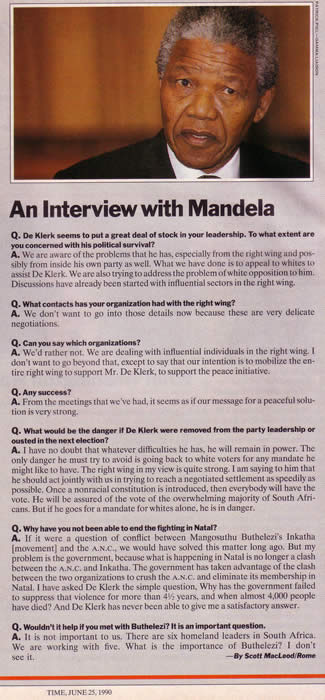 “Q: Why have you not been able to end the fighting in Natal?
“Q: Why have you not been able to end the fighting in Natal?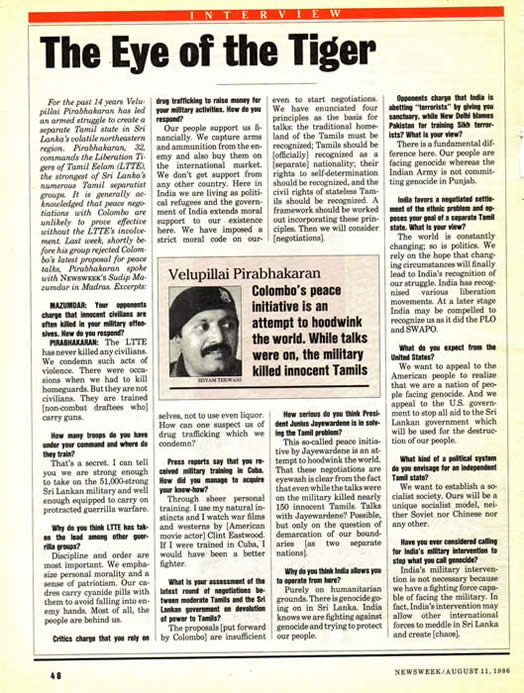 In his interview to the Newsweek magazine in 1986, Prabhakaran answered two posed questions as follows:
In his interview to the Newsweek magazine in 1986, Prabhakaran answered two posed questions as follows:
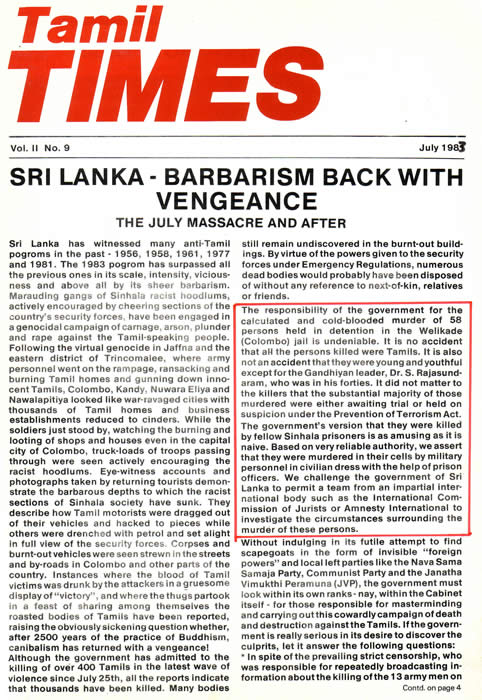
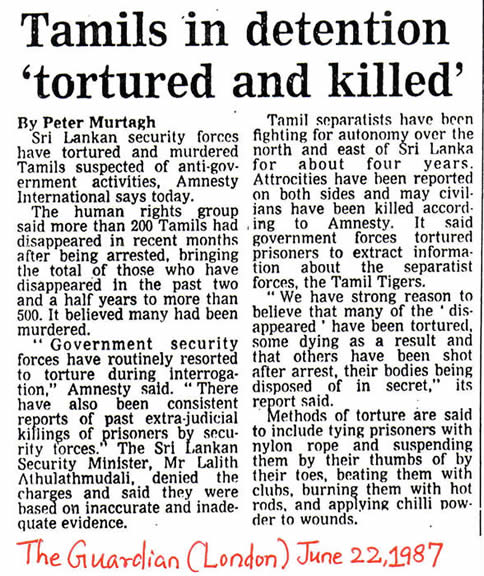
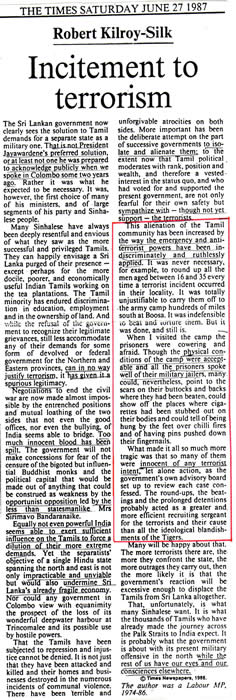 When I visited the camp the prisoners were cowering and afraid. Though the physical conditions of the camp were acceptable and all the prisoners spoke well of their military jailers, many could, nevertheless, point to the scars on their buttocks and backs where they had been beaten, could show off the places where cigarettes had been stubbed out on their bodies and could tell of being hung by the feet over chilli fires and of having pins pushed down their fingernails.
When I visited the camp the prisoners were cowering and afraid. Though the physical conditions of the camp were acceptable and all the prisoners spoke well of their military jailers, many could, nevertheless, point to the scars on their buttocks and backs where they had been beaten, could show off the places where cigarettes had been stubbed out on their bodies and could tell of being hung by the feet over chilli fires and of having pins pushed down their fingernails.